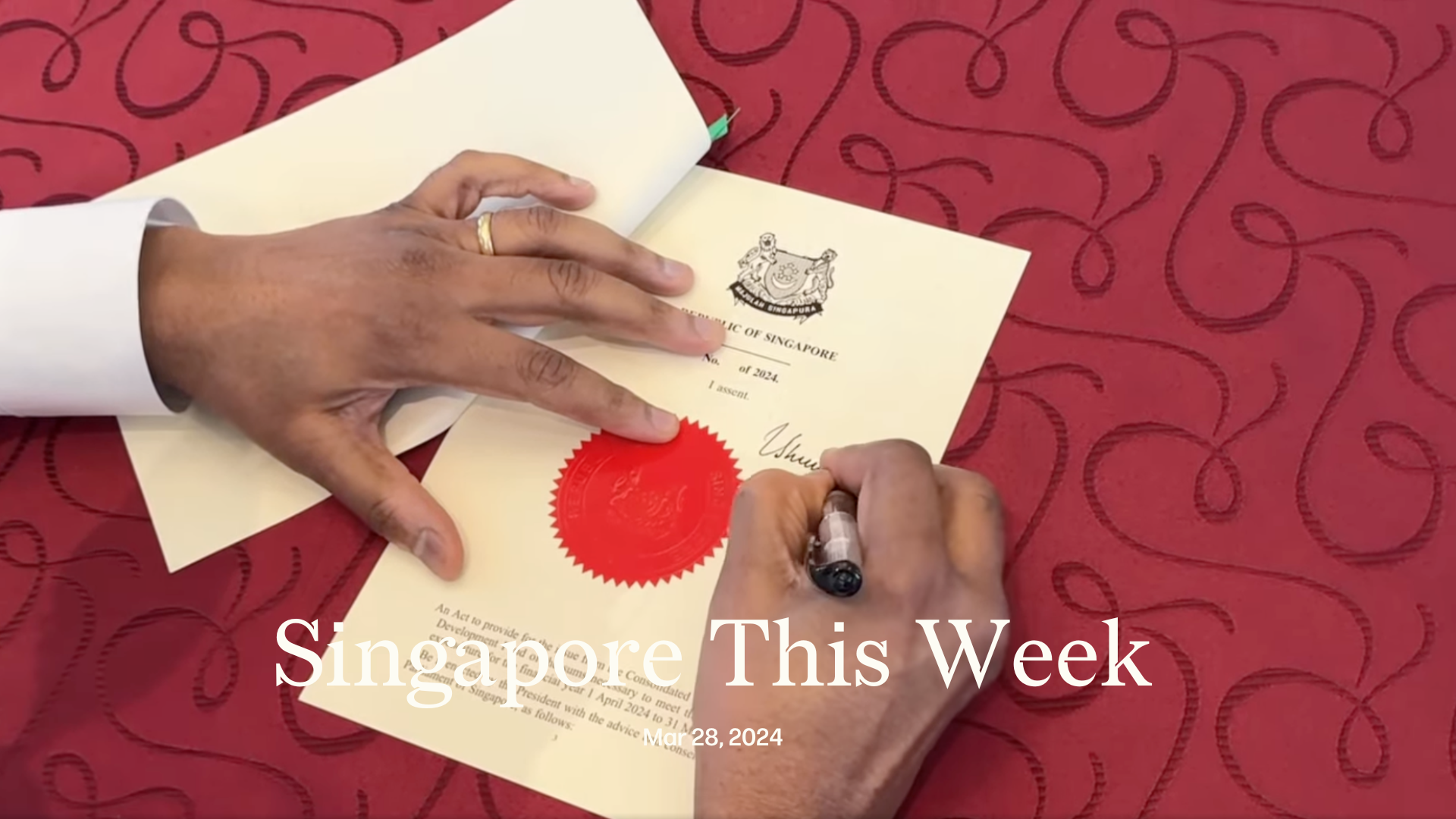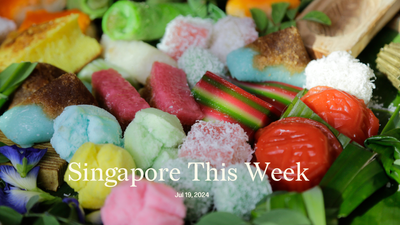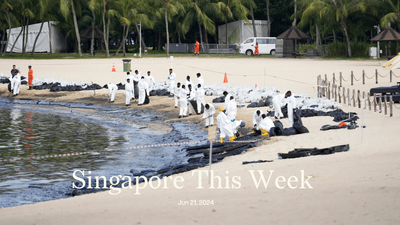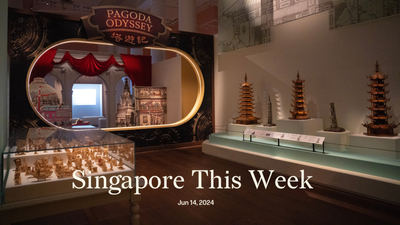Politics: 55 years of the Israel-Singapore love affair
Imagine this revisionist history: “Israel is mentioned 43 times in the Quran. On the other hand, Palestine is not mentioned even once. Each and every archaeological evidence—maps, documents, coins, link the land of Israel to the Jewish people as the indigenous people of land.”
The last sentence is problematic because archaeological evidence points to the tapestry of cultures in the region. The first, on Israel in the Quran, is an interpretive reading of a religious scripture that equates the “children of Israel” with the modern state. The second, on Palestine not being mentioned in the Quran, is true. But those two sentences are cobbled together with the intention to deceive—the Quran is not the basis for the legitimate contemporary claims for a state of Palestine, a region first named by the Ancient Greeks almost a millennia before Islam’s holy text.
Such deception could conceivably poison relations between religious communities. If any Singaporean had engaged in such folly, they might have fallen foul of the Protection from Online Falsehoods and Manipulation Act or even the Maintenance of Religious Harmony Act. But it came from the Embassy of Israel in Singapore’s official Facebook account. This is merely the latest bit of problematic propaganda from the embassy since the October 7th attacks by Hamas. It has put out incendiary stuff on Instagram. And its ambassador last year directly e-mailed parliamentarians with gruesome details of the attacks, two members of Parliament, one from the ruling People’s Action Party (PAP), told Jom. (The embassy and Singapore’s Ministry of Foreign Affairs did not return a request for comment.)
Singapore does not have the same jurisdiction over diplomats from sovereign states as it does its own citizens. On Sunday, the embassy deleted the post following a request from the Singapore government, and claims to have “harshly punished” a staff member. All good, then?
Politics: Our superhuman president’s self-laudatory magic
When Tharman Shanmugaratnam was running for the presidency last year, he said that the president must “be above the political fray” in order to play a “unifying role” for Singapore. He left the PAP and, with his former colleagues’ endorsement, won in September with a thumping 70 percent of the vote. Then, last November, the government controversially amended the Constitution to allow the president to accept international appointments in their personal capacities, subject to some conditions—and even backdated it for Tharman. This change was presented as in Singapore’s best interests, though critics wondered if his former colleagues were doing Tharman a favour (by facilitating his jetsetting, global policymaker life).
Those same critics were irritated last week by an official video from “The Istana Singapore: The President’s Office”, in which Tharman praised the financial prudence of the Budget presented by Lawrence Wong, deputy prime minister and the PAP’s anointed next leader. “Magical thinking always ends up unhappily,” he said, criticising the supposed profligacy of “many countries” who kick the can down the road and give “the next generation a raw deal.” It’s highly unusual for a president to endorse a budget in this way—previous ones just signed off on them without having a videographer zoom in on their hands. More so because it comes in an era when the opposition Workers’ Party has been clamouring for higher government spending from Singapore’s bountiful reserves, for which the president holds the “second key”.
Since Tharman has chosen to pontificate on social media in this way, one can only assume that he’ll also make videos on presidential matters in which he disagrees with Wong. The video is also unusual because Tharman himself, during his time as finance minister (2007-15), was the primary architect of Singapore’s prudent social spending, including eschewing a minimum wage for the (more conservative) Progressive Wage Model. Put another way, in this video, paid for by you, older president Tharman is patting younger minister Tharman on the back. Now that’s magic.
Society: Vicious cycle
Need a loan but don’t want to deal with moneylenders? Here’s what you can do at Lucky Plaza. First, “buy” gold from a jewellery store that offers a zero-down-payment instalment plan. Then, pawn the gold immediately for instant cash. Voilà! Some foreign domestic workers (FDWs) have been doing this. According to one interviewed by TODAY, some shops charge interest of about S$100 per gram of gold on top of the actual price (currently about S$100 per gram). If the instalment plan is over three months, as many suggest, that would translate into an effective annual interest rate of over 300 percent (well above the 48 percent per annum limit for moneylenders).
Two shops said they offer it only to foreigners, not Singaporeans. Are FDWs being unfairly exploited by these shops? It’s a fair question, considering how “[t]he financial stress that low-wage migrant workers…are under may…cause them to act irrationally out of desperation,” said Transient Workers Count Too (TWC2), a migrant workers’ rights group. For their first few months of work in Singapore, FDWs often receive “no or little pay” because most of their salary goes towards repaying employment agents for placement costs. This, in combination with requests for money from family members back home, contribute to the desperation some FDWs experience. In 2019, a loan cap of S$1,500 was introduced for foreigners who earn less than S$10,000 annually in response to the climbing number of FDWs in debt; a study that same year found that a third of FDWs in Singapore are in debt, and almost half of them do not have a bank account.
As a way to circumvent the loan limit, FDWs turned to buying and pawning gold. Some get stuck in a cycle of debt—without sufficient funds to pay off the loan from their first piece of jewellery, they “purchase” another piece, and again immediately pawn it off, just to repay their original debt. FDWs are an invaluable part of Singaporean society, and we all have a stake in protecting them from exploitation. Free financial literacy classes may not be sufficient. For it’s not just the jeweller who’s exploiting them, but the entire system of cheap migrant labour.
Society: If you’re happy and you know it, you’re a boomer
Despite falling five spots to 30th in this year’s World Happiness Report, Singapore remains the happiest country among those surveyed in Asia (ahead of Malaysia, the Philippines, Thailand and Vietnam). But are people here really happy? The answer seems to depend on whom you ask. Residents under 30 reported a significantly lower quality of life than those over 60 (ranked 54th and 26th in their respective age groups globally). This generational disparity could be attributed to the young feeling that the “Singapore Dream” was “less easily accessible compared to their middle-class parents, who had experienced upward mobility in the late 70s and early 80s”, Tan Ern Ser, a sociologist, told South China Morning Post.
Published by the Wellbeing Research Centre at Oxford University, the UN-sponsored report covers about 1,000 respondents in each of the 143 countries surveyed from 2021-23. These rankings are based on life evaluations and consider how six key variables—gross domestic product per capita, social support, healthy life expectancy, freedom, generosity and corruption—contribute to well-being indicators, including positive (laughter, enjoyment and interest) and negative (worry, sadness and anger) emotions. But Singapore’s state of happiness has received a mixed response online. One Reddit user noted: “This says more about the dismal state of a lot of countries rather than our happiness.” One took aim at monied elites: “Which part of Singapore? CECA [Comprehensive Economic Cooperation Agreement with India] enclave, PRC [People’s Republic of China] clusters or foreign expat village?” As to the discrepancy between under 30s and over 60s, a user surmised: “Over 60 are boomers who get [to]…enjoy the fruit of gov polices…healthcare subsidies, and flipping of their HDB/Condos.”
These reactions appear to align with results from past surveys. The 2022 Quality of Life Survey found that Singaporeans are less happy than five years ago—having felt a decreased sense of achievement, control and purpose. While another reported that Singapore workers under 40 were three times more likely than peers 10 years their senior to be diagnosed with anxiety and depression. Has happiness become an elusive dream? Viktor Frankl, philosopher and Holocaust survivor, perhaps summed it up best: “It is the very pursuit of happiness that thwarts happiness.”
History weekly by Faris Joraimi
Last Friday, March 22nd, was the birthday of the late P Ramlee (1929-1973): composer, musician, actor, filmmaker and star of mid-20th century Malayan entertainment. To coincide with the occasion, the National Archives of Singapore launched “Remembering the Golden Age of Malay Cinema: P. Ramlee”, an initiative celebrating his “profound impact on Singapore’s artists, audiences and film industry, past and present”. It includes an online exhibition containing audiovisual clips from Ramlee’s vast oeuvre as well as interviews with his former collaborators and colleagues. A highlight for me is an oral history interview with L Krishnan, the Madras-born film director who made movies in Singapore for both of the city’s then-dominant studios, Shaw Brothers and Cathay-Keris. Krishnan, who realised Ramlee’s talent and gave him his first acting roles, explained that the first Malay screenplays were all translations or adaptations of Tamil, Hindustani and Chinese films. This continued a tradition of urban Malay mass entertainment at the time, namely bangsawan, which also staged stories from around the world. It shouldn’t be surprising that Malay was the medium, and Singapore the place, for these narrative styles and references from across Asia to meet, combine and produce “modern” popular culture.
With its multiethnic labour, audiences and creative inspirations, Malay cinema was global cinema: a claim that’s only awkward if we uphold “major” cinema traditions like those of Europe, America or Japan as signifiers of “global” culture, or the Asian auteurs whose works travel outside their context, to show at the usual centres of international recognition (Cannes, Berlin, Venice). Ramlee’s works did travel, winning awards at film festivals in Tokyo, Hong Kong and Taipei. Far from being marked by a failure to travel, Malay cinema continues to exceed classification into any single national media history. Ramlee himself, an Acehnese born and raised in Penang before moving to Singapore, straddles three nation-states that occupy the once-fluid Melaka Straits. Despite initiatives like that of the National Archives (which follows earlier tributes to Ramlee here in 1999 and 2010), and the many commemorations in Malaysia which honour him as a national hero, Ramlee and his work existed before the nation-state took us out of globality. Both countries today have valid “claims” over this artistic heritage, but I also think neither fully does. The films, like mirrors, show our bordered world to be as much an illusion. As Dan Koh wrote in his review of “La Luna” and a Malayan subconsciousness, “certain pictures retain powers beyond their immediate time.” In part, these living powers derive from a Malaya that still talks, sings, and moves.
Arts: Daily poets society
“Poetry is coming!” That’s the rallying cry of the Singapore literary community gearing up for the 11th year of the beloved poetry writing challenge: Singapore Poetry Writing Month, or SingPoWriMo. For the entire month of April, participants commit to writing a poem a day. They can choose to riff off prompts dispensed by a team of moderators, usually prominent poets who in the past have included former Singapore Writers Festival director Pooja Nansi and spoken word trailblazer Stephanie “Dogfoot” Chan. Or they can write whatever they want, stretching the borders of what constitutes a poem. The collective creative output of over 7,000 people is something quite glorious (and delirious) to behold.
Over the past decade, the SingPoWriMo community has established its own vernacular—and a tentacular network of internal referencing. This hashtag index is as systematic as it is wilfully anarchic. There’s #plscrit if participants want community edits, #gentlecrit if they prefer positive feedback, and #modspls (“mods pls!!!”) as a shorthand to alert moderators to outstanding poems that might eventually be shortlisted for a digital anthology. But participants have also created their own inventories of hashtags incorporating inside jokes, memes, and elaborate parallel universes of troll poetry. The daily prompt drop is highly anticipated; you’ll get folks lurking around the page at midnight, ready to type. These prompts are very much their own artform, and can range from content prompts (write about the street where you live or your favourite fungi) to form prompts: writer Ng Yi-Sheng once got participants to experiment with the Burmese Thanbauk poetic form in conjunction with Thingyan, the Burmese New Year, and also included a link to fundraisers for mutual aid in Myanmar given the ongoing and brutal military coup and civil war.
Organised by local literary nonprofit Sing Lit Station, SingPoWriMo has also acquired a growing list of corporate sponsors, and past prompt winners have scored everything from literary merch to theatre tickets (or just good old bragging rights). SingPoWriMo has also produced a smaller South-east Asian spinoff (SeaPoWriMo), which runs for two weeks in August. Both communities are particularly generous towards beginners, and their tireless teams of moderators do their best to foster literary relationships and offer constructive feedback to anyone who asks for it. So if you’ve ever fancied some verse in the “Metaverse”, this year is as good a time as any to start.
Arts: Feelers and the art of tech-tility
NFTs, AI, Web3: nascent technology frequently embodies the art world’s greatest fads and worst fears. Instead of recoiling from or panicking about these developments, the art and tech research lab Feelers has chosen to approach assumptions around the arts and technology with both playfulness and sensitivity. This lab doesn’t publish academic papers—instead, they produce artwork and education programmes as outcomes of their research, including their popular School of Alternate Internets. Their inaugural season, Touch Base, runs from March to May and features a series of workshops, performances, gatherings and discussions that blend high-tech inquiry with what they call “low-tech instincts”.
You can speculate about a wild tech future by playing “Cards Against Technology”, their tongue-in-cheek subversion of Cards Against Humanity, or feel your way through a tactile dialogue with your devices in the movement workshop “Random Access Memory”. A work-in-progress excerpt of their first performance project, “perfor.ml”, will be presented in April under the auspices of the National Arts Council’s (NAC) and Esplanade’s Performing Arts x Tech Lab, set up to encourage artists to experiment with tech and how it might provoke or be integrated into their practices. “perfor.ml” is set in a subsea data centre and brings together human performers and kinetic sculptures on stage. This undersea exploration is also the start of a longer-term journey of considering the machine as a collaborator, with its own idiosyncrasies and character traits. “perfor.ml” isn’t the only culmination of the nine-month Lab process. Many of the incubated works live in this intersection of the body, movement and tech, interrogating everything from motion capture technology to interactive sensor systems.
From all the upcoming Lab presentations, one throughline is clear: it’s curiosity and collaboration that will allow us to respond thoughtfully to tech and shape a new ethical framework for difficult questions around privacy, surveillance, extraction and isolation. As the Feelers team puts it: “Our projects are invitations to think critically and empathetically about the world we live in...While art and technology form key fields of research, they continually lead us back to one another. It is with one another that our real work takes place.”
Tech: DBS goes big on lending to Indian start-ups
DBS Bank India has pledged US$250m (S$337.1m) in lending to the country’s start-ups, heralding a possible thaw in the ongoing “funding winter” that has gripped India’s otherwise vibrant start-up ecosystem. It’s a strategic move to propel local innovation and entrepreneurship in sectors ranging from tech and healthcare to those using artificial intelligence in finance, retail, and logistics. With Indian start-ups experiencing a sharp decline in fundraising—from US$41.4bn (S$55.8bn) in 2021 to just US$7bn (S$9.4bn) in 2023—DBS Bank India’s pledge indicates a positive outlook on the fundraising climate for the year ahead. Similarly, Rajan Anandan of VC firm Peak XV (formerly known as Sequoia Southeast Asia & India), anticipates a fundraising rebound to between US$8bn (S$10.8bn) and US$12bn (S$16.2bn) in 2024. This recovery is crucial for sustaining India’s entrepreneurial dynamism. Beyond lending, the bank has also supported the ecosystem through the Businessclass FoundED forum, which engaged over 1,000 start-ups and 50 incubators. This combined financial support and community engagement could set an example for how Singaporean financial institutions can contribute to the growth of overseas start-ups.
Tech: Anywheel becomes the largest bike-sharing player
Remember the days of the streets being littered with bikes? Singapore has come a long way in terms of accommodating bike-sharing firms. Yet financial sustainability continues to be a challenge, with the latest casualty being SG Bike, which will cease operations by April 30th. This so-called “strategic shift in business direction” underscores the operational and competitive challenges within the sector. SG Bike’s closure is not just the end of its own seven-year ride, but also a significant development for the whole sector, for it narrows the race to just two: Anywheel and HelloRide. Singapore’s bike-sharing scene has seen dramatic changes since its inception. There was an initial influx of mainly Chinese firms aiming to replicate their domestic success. Singaporean authorities eventually tightened regulations, leading to a shakeout, which left SG Bike and Anywheel as the only entities capable of meeting regulatory requirements. This regulatory environment, although ensuring safety and operational accountability, also set a high barrier for market success—exemplified by SG Bike’s financial struggles, with accumulated losses of US$5.5m (S$7.4m) in financial year 2022. The consolidation of Singapore’s bike-sharing market, now primarily between Anywheel and Alibaba-backed HelloRide, could impact user choice, pricing, and service innovation. Anywheel currently dominates, with 30,000 bikes and 1.3m users, compared with HelloRide, which last year secured a licence to expand its (then) fleet of 1,000 to 10,000. These are the dynamics of the latest chapter in the city-state’s tumultuous bike-sharing story.
If you enjoy Jom’s work, do get a paid subscription today to support independent journalism in Singapore.







